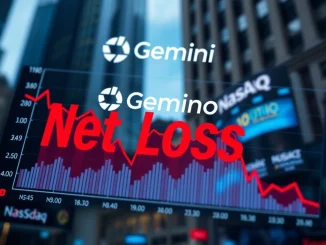
In a fascinating twist on the usual narrative of traditional finance adopting crypto, a prominent figure in the digital asset space has proposed a bold reversal. Andrei Grachev, the insightful co-founder of crypto market maker DWF Labs, recently shared his perspective on X (formerly Twitter), suggesting that if traditional finance isn’t quick enough to embrace the world of altcoins, then perhaps altcoins should take the initiative and move into the TradFi sector themselves. This idea sparks a compelling conversation about the future integration of digital assets and established financial markets.
Why Altcoins Should Target Traditional Finance Investors
Grachev’s core argument stems from the perceived slow pace of traditional finance players entering the vibrant, yet sometimes volatile, altcoin market. While institutions are increasingly interested in Bitcoin and Ethereum, broader altcoin adoption by major financial institutions has been limited. His solution? Flip the script. Instead of waiting for TradFi to come to altcoins, crypto projects should proactively build bridges to attract traditional investors.
The DWF Labs co-founder believes that crypto projects need to create structures that are familiar and accessible to traditional investors. This is where the concept of a Nasdaq listing comes into play.
The Nasdaq Listing Strategy for Altcoins
According to Grachev, a key pathway for altcoins to penetrate the traditional finance market is through vehicles listed on major stock exchanges like Nasdaq. He envisions a scenario where crypto projects could have publicly traded entities whose value is linked to the underlying altcoin or the project’s performance.
Here’s a breakdown of the proposed mechanism:
- **Nasdaq Listed Vehicles:** Crypto projects would establish corporate structures or investment vehicles that can be listed on stock exchanges. These could be similar to companies holding significant crypto reserves or entities whose business model directly involves the altcoin.
- **Capture Traditional Investors:** By listing on a platform like Nasdaq, these vehicles become accessible to a massive pool of traditional investors who might not be comfortable buying altcoins directly on crypto exchanges due to regulatory uncertainty, technical barriers, or unfamiliarity.
- **Convert to Token Holders:** The innovative part of Grachev’s idea is the goal of converting these traditional shareholders into long-term token holders. This could potentially be achieved through incentives, educational programs, or mechanisms that allow shareholders to convert their shares into tokens over time, or benefit from token-specific utilities or rewards.
This strategy essentially uses the familiar and regulated framework of traditional finance to onboard a new class of investors into the crypto ecosystem.
Boosting the Crypto Market Through TradFi Integration
The primary objective of this strategy, as underscored by Grachev, is to significantly boost the overall crypto market. Bringing traditional finance investors, with their vast capital pools and long-term investment horizons, into the altcoin space could have several positive impacts:
- **Increased Liquidity:** More participants and capital flowing into altcoins would naturally increase market liquidity, making it easier to buy and sell assets.
- **Enhanced Stability:** Traditional investors often have a longer-term view compared to some crypto traders, potentially introducing more stability and reducing volatility in the altcoin market.
- **Broader Adoption:** Successful integration could pave the way for wider acceptance and understanding of altcoins among the general public and financial institutions.
- **Capital Influx:** Accessing traditional capital markets could provide altcoin projects with significant funding opportunities beyond traditional crypto fundraising methods.
This cross-pollination could accelerate the maturation and growth of the entire crypto market ecosystem.
Challenges and Feasibility of Altcoins Entering Traditional Finance
While Grachev’s vision is compelling, executing such a strategy comes with significant challenges:
- **Regulatory Hurdles:** Listing crypto-related vehicles on major exchanges like Nasdaq would face intense scrutiny from regulators (like the SEC in the US). Clear regulatory frameworks for such structures are still evolving.
- **Structure Complexity:** Designing a vehicle that effectively tracks or represents an altcoin while complying with securities regulations is complex. How would tokenomics, staking rewards, or governance rights be reflected for shareholders?
- **Investor Education:** Converting traditional shareholders into active token holders requires substantial education and infrastructure to manage wallets, exchanges, and the nuances of token ownership.
- **Market Perception:** Traditional investors might remain wary of the volatility and perceived risks associated with altcoins, even when accessed via a familiar stock market structure.
Despite these challenges, the idea highlights the innovative thinking happening in the space to bridge the gap between digital assets and legacy finance.
The Role of DWF Labs in Bridging Crypto and Traditional Finance
As a prominent crypto market maker, DWF Labs plays a crucial role in providing liquidity and supporting the markets for various digital assets, including altcoins. Their perspective on integrating altcoins with traditional finance is particularly relevant.
Market makers benefit from increased market activity and depth. A successful strategy to bring traditional capital into the altcoin market would likely lead to more trading volume and potentially more stable markets, aligning with the business interests of firms like DWF Labs. Their experience navigating crypto markets could also be invaluable in developing the mechanisms needed for traditional finance integration.
Summary: A New Direction for Altcoin Growth
Andrei Grachev’s suggestion that altcoins should proactively seek entry into the traditional finance sector via Nasdaq listings offers a fresh perspective on crypto adoption. Instead of solely relying on TradFi to build crypto products, this strategy proposes crypto projects build TradFi-friendly access points.
While ambitious and fraught with regulatory and structural challenges, the concept of using familiar vehicles like stock listings to attract traditional investors and potentially convert them into long-term token holders is a powerful one. If successful, such initiatives could unlock significant capital, boost the entire crypto market, and accelerate the mainstream integration of altcoins, fundamentally changing how traditional finance interacts with the digital asset world.



